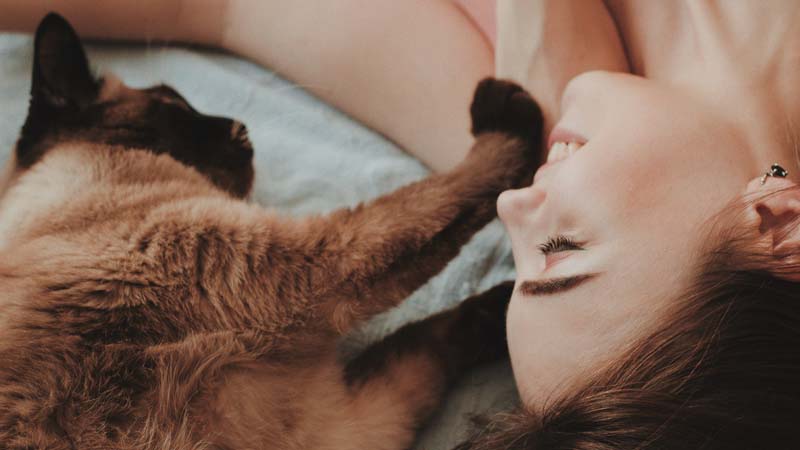Feline Affection: How to Tell if a Cat Loves You

Photo by Oleg Ivanov on Quora
Cats are intriguing creatures who often display a complex range of behaviors, making deciphering their feelings challenging. While some might perceive them as aloof or distant, felines have unique ways of expressing their affection. Understanding and decoding these subtle signs can provide insight into the deep bond that exists between you and your furry companion.
In this article, we will explore the various signs that indicate a cat's love and how to tell if a cat loves you.
The Language of Feline Affection
1. Purring: The universal language of contentment. Cats often purr when they feel happy, relaxed, or even when seeking comfort. The gentle vibration is their way of saying, "I'm comfortable and at peace."
2. Kneading: When your cat rhythmically presses and kneads its paws against you, it's a reminiscent behavior from kittenhood, indicating comfort and trust.
3. Slow Blinking: A slow, deliberate blink from your cat is a sign of trust and affection. Returning the blink is akin to saying, "I trust you too."
4. Head Butting or Bunting: When your cat gently bumps its head against you, it's a sign of familiarity and affection. This behavior marks you with its scent, claiming you as part of its territory.
5. Tail Language: A cat's tail serves as a mood barometer. A relaxed, upright tail or one that twitches slightly at the tip indicates a friendly and contented mood. Conversely, a puffed-up tail might signal fear or agitation.
6. Gift Giving: Bringing you "presents" like dead mice or toys might seem unusual, but it's their way of sharing their hunting success with someone they care about.
7. Closeness and Proximity: Cats often choose to be near individuals they trust and love. Curling up next to you or following you around the house is their way of seeking companionship.
Understanding Individual Personalities
Every cat has a unique personality. Some may be more overtly affectionate, while others express their love in subtler ways. Factors such as breed, upbringing, and past experiences also influence their behavior.
Social Cats vs. Independent Cats: Social breeds like Siamese or Ragdoll cats tend to be more demonstrative with their affection. In contrast, breeds like the Maine Coon or Norwegian Forest Cat might show affection in quieter, more reserved ways.
Past Trauma or Rescued Cats: Cats that have experienced trauma or were rescued might take longer to trust and show affection. Patience, gentleness, and consistency are crucial in building a strong bond.
Age and Developmental Stage: Kittens might exhibit different forms of affection compared to adult or senior cats. As they mature, their ways of expressing love might evolve.
Addressing Your Cat's Need for Love
To foster a strong emotional connection with your feline companion, it is essential to understand their unique individual needs and preferences. The following practices can help strengthen your cat's love and attachment:
Quality Time:
Investing dedicated time and attention in your cat strengthens the emotional bond. Engaging in activities that your cat enjoys, such as interactive play, grooming, or simply being present, fosters feelings of trust and affection.
Positive Reinforcement:
Reward your cat's displays of affection with praise, treats, and gentle words. Positive reinforcement encourages good behaviors and fosters trust and emotional attachment.
Understanding Personal Space:
Respect your cat's personal space and approach them on their terms. This respect demonstrates your understanding of their needs and preferences, contributing to the formation of a strong and positive emotional bond.
Safe Haven and Comfort:
Creating a safe and comfortable environment for your cat establishes feelings of security and promotes emotional attachment. Ensure access to resources such as food, water, and comfortable sleeping areas. Additionally, providing hiding places and quiet spaces allows them a comfortable, secure environment they will appreciate.
Regular Health and Care:
Caring for your cat's health is a fundamental component of your bond. Schedule regular veterinary check-ups, provide proper nutrition, and address any health concerns promptly. By maintaining their well-being, you demonstrate your commitment to their happiness and longevity.
Conclusion
Cats are fascinating creatures capable of displaying a range of emotions and bonding with their human caregivers. While deciphering their emotions can be challenging, observing their body language and behavior provides insights into their feelings of love and attachment. By investing time, attention, and care, we can strengthen the bond with our cats, creating a lifelong companionship filled with love, trust, and mutual happiness.
As cat owners, it is our responsibility to reciprocate this love and affection, providing a nurturing and loving environment that allows our cats to flourish. By investing time, attention, and care, we can strengthen the bond with our cats, creating a lifelong companionship filled with love, trust, and mutual happiness.
The unique bond between cats and their humans is a testament to the depth of their emotional capacity and their ability to form meaningful connections. Understanding the various signs that indicate a cat's love can strengthen the emotional connection, promoting mutual happiness and well-being.
You May Also Like
 Cat BehaviorIf The Cat Is Well Raised, There Will Be These 6 Behaviors!
Cat BehaviorIf The Cat Is Well Raised, There Will Be These 6 Behaviors! Breed Reviews6 Advantages Of Raising A Male Cat, More Suitable For Novices
Breed Reviews6 Advantages Of Raising A Male Cat, More Suitable For Novices Cat BehaviorCat Wants To Hug, There Are 5 Movements, Do You Know?
Cat BehaviorCat Wants To Hug, There Are 5 Movements, Do You Know? Breed Reviews10 Best Cat Breeds for First-Time Owners
Breed Reviews10 Best Cat Breeds for First-Time Owners Cat Behavior & TrainingLoving Them Right: Let Cats Play!
Cat Behavior & TrainingLoving Them Right: Let Cats Play! Cat GroomingTips and Tricks on How to Take Care of Your Cat
Cat GroomingTips and Tricks on How to Take Care of Your Cat